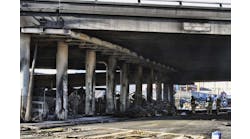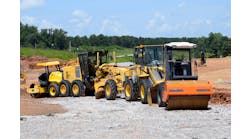Data from a new government report shows that if all the structurally deficient bridges in the U.S. were placed end-to-end, it would take 25 hours driving 60 mph to cross them. That’s like driving the 1,500 miles between Boston and Miami. And it’s a problem that’s close to home.
An analysis of the 2013 National Bridge Inventory database recently released by the U.S. DOT shows cars, trucks and school buses cross the nation’s more than 63,000 structurally compromised bridges 250 million times every day. The most heavily traveled are on the interstate system.
The problem could get a lot worse, the chief economist for the American Road & Transportation Builders Association (ARTBA) says, as states across the nation face a slowdown in reimbursements for already-approved federal-aid highway projects in August. Without Congressional action, Dr. Alison Premo Black said there will be no Highway Trust Fund support for any new road, bridge or public transportation projects in any state during FY 2015, which begins Oct. 1.
“Letting the Highway Trust Fund investment dry up would have a devastating impact on bridge repairs,” Black said, noting the trust fund has supported $89 billion in bridge construction work by the states over the past 10 years. “It would set back bridge improvements in every state for the next decade.”
“The bridge problem sits squarely on the backs of our elected officials,” Black said. “The state transportation departments can’t just wave a magic wand and make the problem go away. It takes committed investment by our legislators. Members of Congress need to come to grips with that. Some of our most heavily traveled bridges were built in the 1930s. Most are more than 40 years old.”
Bridge decks and support structures are regularly inspected by the state transportation departments for deterioration and are rated on a scale of zero to nine—nine being “excellent” condition. A bridge is classified as structurally deficient and in need of repair if its overall rating is four or below.
While these bridges may not be imminently unsafe, ARTBA suggests they be sign posted so the public knows they have structural deficiencies that need repair.
The ARTBA analysis of the bridge data supplied by the states to the U.S. DOT found:
- The 250 most heavily crossed structurally deficient bridges are on urban interstate highways, particularly in California. With one exception, all are at least 39 years old;
- Pennsylvania (5,218), Iowa (5,043), Oklahoma (4,227), Missouri (3,357) and California (2,769) have the highest number of structurally deficient bridges; Nevada (36), Delaware (56), Utah (117), Alaska (133) and Hawaii (144), the least; and
- At least 20% of the bridges in four states—Pennsylvania (23%), Rhode Island (22%), Iowa (21%) and South Dakota (21%)—fall in the structurally deficient category.
State-specific bridge information from the analysis—including rankings and location lists of the 250 most heavily traveled structurally deficient bridges in the nation and 10 most heavily traveled in each state—is available in the “Economics” section of www.artba.org.


